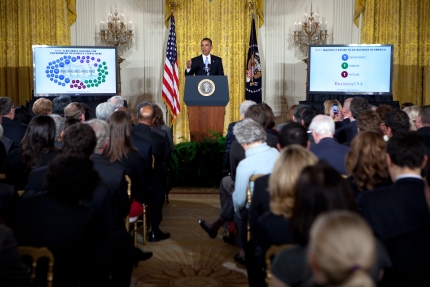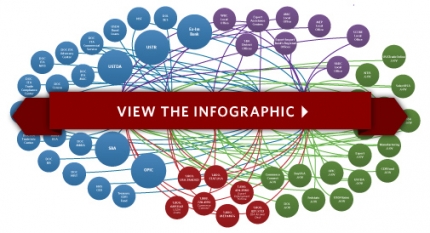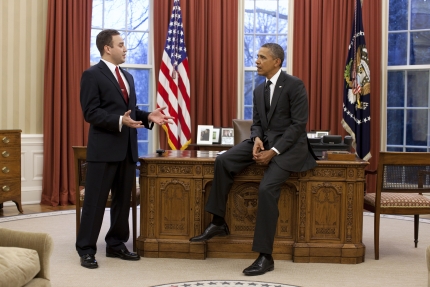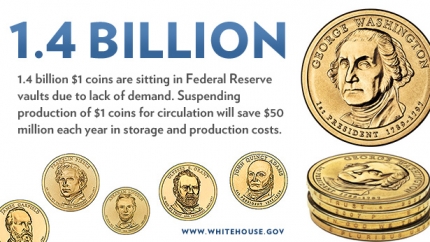Reform & Fiscal Responsibility News
Patent Reform: Celebrating the One Year Anniversary of the America Invents Act
Posted by on September 17, 2012 at 1:28 PM EDTOn September 16, 2011, President Obama signed into law one of the most significant legislative reforms to the patent system in our Nation’s history. The America Invents Act was passed with the President’s strong leadership last year, after nearly a decade of effort.
A year later, the U.S. Patent and Trademark Office is implementing the legislation in a manner that makes it easier for American entrepreneurs and businesses to bring their inventions to the marketplace sooner, converting their ideas into new products and new jobs. It will help companies and inventors avoid costly delays and unnecessary litigation, and let them focus instead on innovation and job creation.
As a number of important provisions of the law go into effect this week, we can already see substantial progress towards the law’s goals. Patent applications filed today will take nearly 40 percent less time to receive an initial patentability determination on their innovation compared to January 2009. The new Track One program provides a fast-track option for processing within 12 months, and offers discounts for small inventors. And the backlog of patent applications has been reduced to its lowest point in years. The USPTO’s continued focus on improving patent quality will be aided by new trial proceedings that provide an affordable alternative to litigation to review the merits of existing patents. A final decision in each case will be issued in less than a year. The USPTO has also published for review a proposed fee schedule that will expand an existing 50 percent discount on patent application fees for small entities. A new program for micro-entities—individuals or very small enterprises— offers a 75 percent fee discount. A USPTO-driven pro bono program—launched first in Minnesota and now being introduced in Colorado and California, with many more locations on tap for 2013—helps cash-strapped inventors receive the legal help they need to obtain patents.The USPTO will also open new satellite offices in Denver, Silicon Valley, and Dallas-Fort Worth, in addition to the first satellite office in Detroit, Michigan that opened in July 2012. These offices will help further reduce the patent application backlog and help local innovators raise capital and get their inventions to market more rapidly.
A Smarter Approach to Regulation
Posted by on August 7, 2012 at 5:27 PM EDTWatch the White House white board here.
Since taking office, President Obama has been committed to eliminating red tape and ensuring that when rules are issued to protect safety and health, they are sensitive to the economic situation and attuned to the importance of job creation and economic growth.
As this White House White Board shows, the net benefits, or the benefits minus the costs, of regulations issued through the third fiscal year of the Obama Administration have exceeded $91 billion. This amount, including not only monetary savings but also thousands of lives saved and tens of thousands of illnesses and injuries prevented,is over 25 times the net benefits through the third fiscal year of the previous Administration. What are the ingredients of these benefits?
Learn more about Economy, Additional IssuesReforming Wall Street, Protecting Main Street: An Update on Wall Street Reform
Posted by on July 19, 2012 at 3:40 PM EDTEd. note: This is cross-posted from Treasury Notes
Two years ago this week, President Obama signed the Dodd-Frank Wall Street Reform and Consumer Protection Act -- the most significant set of financial reforms since the Great Depression. The landmark law is designed to help protect Americans from the excessive risk, fragmented oversight, and poor consumer protections that played leading roles in bringing about the recent financial crisis.
Treasury and the independent regulators have made meaningful progress implementing the law, which is vital to restoring trust in the underlying safety, stability, and integrity of the financial system, and to rebuilding a pro-growth, pro-investment environment. To outline the progress made, the U.S. Department of the Treasury has developed an overview of where reform stands and the changes it has effected on the financial system to date. For a copy of the overview, please click here.
Learn more aboutSo How Many Consumer Reporting Companies Are There?
Posted by on July 17, 2012 at 4:57 PM EDTEd note: The Consumer Financial Protection Bureau (CFPB) announced yesterday that they adopted a rule to begin supervising larger consumer reporting agencies, which include what are popularly called credit bureaus or credit reporting companies. This is the first time these companies will be supervised at the federal level. This blog post, originally published on the CFPB blog, explains what this will mean for consumers.
You may know about the three biggest nationwide credit reporting companies: Experian, Equifax, and TransUnion. But did you know that there are other companies out there that may be providing reports on you that could be used to decide if you’re eligible for consumer financial, insurance, medical and other products?
Today the CFPB is posting a list of consumer reporting companies – companies that collect information and write reports that could be used to decide if you will be able to get credit, insurance, or a job. This list doesn’t cover every company in the industry. It’s a list of companies that have identified themselves as consumer reporting companies or provide consumers access to their consumer reports. (1) The list includes both the biggest nationwide credit reporting companies and a longer list of “specialty reporting companies.”
Specialty reporting companies focus on certain industries. Just like the three biggest nationwide credit reporting companies, specialty reporting companies collect and share information with creditors and other businesses. There are a lot of these companies on the list, so we’re also trying to give tips on which of them may be important to you. The list also has information about how you can get copies of your reports (see below).
Learn more about Economy,Weekly Address: Congress Must Move Forward, Not Back On Wall Street Reform
Posted by on May 19, 2012 at 5:30 AM EDTPresident Obama discusses the reforms to Wall Street that he put in place to protect consumers and make Wall Street play by the same set of rules -- and calls on lawmakers to finish implementing these reforms so that we can prevent excessive risk-taking and help create an economy that is built to last.
Transcript | Download mp4 | Download mp3
Learn more about Economy,Making Regulation Smarter to Save Lives and Money
Posted by on May 10, 2012 at 9:15 AM EDTSmart regulations save lives and dollars. For example, the number of deaths on the highways is now down to its lowest level in over 60 years. This is an extraordinary achievement, produced not only by the commitment and creativity of the private sector but also by educational and regulatory initiatives from local, state, and national governments. In areas that include food and workplace safety, clean air, fuel economy, energy efficiency, and investor protection, well-designed regulations are preventing tens of thousands of premature deaths and hundreds of thousands of illnesses and accidents -- and saving billions of dollars.
Under the President’s direction, we have finalized rules, in our first three years, with more than $91 billion in net benefits – over 25 times the corresponding figure in the first three years of the Bush Administration, and over 6 times the corresponding figure in the first three years of the Clinton Administration.
But we don’t need all of the regulations that are on the books. By streamlining some and eliminating others, we can save billions of dollars in unnecessary costs. As President Obama has emphasized, it is possible, even indispensable, both to issue sensible, protective regulations and to eliminate rules that are no longer justified. Today, we are taking three important steps in that direction.
Learn more about EconomyPresident Obama’s Record, Results and Agenda on Income Inequality
Posted by on April 13, 2012 at 9:00 AM EDT“This is a make-or-break moment for the middle class, and for all those who are fighting to get into the middle class. Because what’s at stake is whether this will be a country where working people can earn enough to raise a family, build a modest savings, own a home, secure their retirement.” -- Remarks by the President on the Economy in Osawatomie, Kansas, December 6, 2011
The President has been focused on working to ensure an America that grows together, rather than one in which the gains go disproportionately to the wealthy. His policies have already made a real contribution to achieving this ideal—benefiting millions of people, principally middle-class Americans and those struggling to get into the middle class—and he continues to push tirelessly for policies, including the Buffett Rule, that will help us get closer.
The best available data on incomes refute the baseless claim recently made by some that income inequality is worse under President Obama than it was under President George W. Bush. More fundamentally, whereas the previous Administration’s policies were tilted towards the wealthiest Americans, President Obama has been focused on the middle class and those working to get into the middle class.
Inequality Was Worse Under President Bush than Under President Obama
According to the latest data from economist Emmanuel Saez, when the last economic expansion ended in 2007, the fraction of income going to the top 1 percent was the highest since 1928 and the fraction of income going to the top 0.1 percent was the highest ever recorded (the data go back to 1913). The share of income going to the very top remains high, but has come down and was lower in both 2009 and 2010 than in any year from 2005 through 2008.
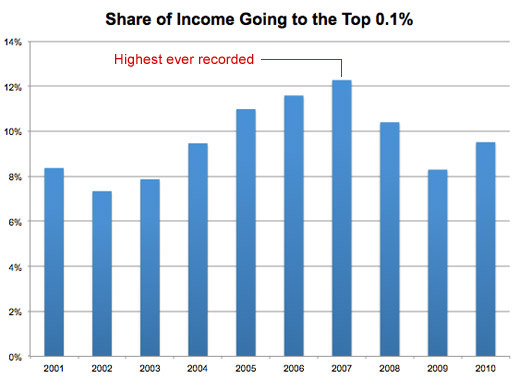
It is difficult to evaluate changes in inequality over very short periods of time, especially when these coincide with a deep recession and dramatic fluctuations in equity prices. But there is no basis in the data for claiming that inequality under President Obama is greater than the historic levels reached under President Bush. Any suggestion to the contrary is based on a combination of ignoring the most obvious facts and treating the dramatic recovery of the stock market in 2009 and 2010 as if it tells a deeper structural story about the economy.
Three Charts Illustrating Two Different Visions for Our Nation
Posted by on April 3, 2012 at 2:07 PM EDTThe President believes this is a make or break moment for the middle class and those working to reach it. That’s why he has put forward a blueprint for an economy built to last - one where everyone gets a fair shot, everyone does their fair share, and everyone plays by the same rules.
Today at the Associated Press Luncheon, the President discussed how his vision differs with the radical vision laid out in the House Republican Budget:
“This Congressional Republican budget, however, is something different altogether. It’s a Trojan Horse. Disguised as deficit reduction plan, it’s really an attempt to impose a radical vision on our country. It’s nothing but thinly-veiled Social Darwinism. It’s antithetical to our entire history as a land of opportunity and upward mobility for everyone who’s willing to work for it – a place where prosperity doesn’t trickle down from the top, but grows outward from the heart of the middle class. And by gutting the very things we need to grow an economy that’s built to last – education and training; research and development – it’s a prescription for decline.”
The President’s approach to reducing our deficit is a balanced approach that asks the wealthiest to pay their fair share, achieves significant health savings and enacts sensible spending cuts while making the investments we need to have a strong middle class.
Take a look at how the President’s approach and the Congressional Republican policies stack up side by side:
Business Leaders Respond to President Obama's Executive Order on Infrastructure Permitting
Posted by on March 27, 2012 at 3:17 PM EDTLast week, President Obama signed an Executive Order directing Federal agencies to expedite permitting and review decisions for key infrastructure projects – a critical step in improving our nation’s infrastructure and maintaining our competitive edge. U.S. business leaders and members of the President’s Council on Jobs and Competitiveness put out statements in support of the new Executive Order:
NextEra Energy, Inc., Chairman and CEO Lew Hay issued the following statement on the "Executive Order on Improving Performance of Federal Permitting and Review of Infrastructure Projects" :
"America's infrastructure requires continued investment by the private sector and by many government agencies to enhance our global competitiveness and to ensure greater opportunity for the next generation of American entrepreneurs. Such investments in infrastructure, including clean and efficient power generation, are rightly subject to numerous federal regulations to protect the environment, to enhance the health and safety of the American people, to ensure transparency and accountability, and to serve the public interest. Yet the sum total of these regulations, combined with those of states and other jurisdictions, often delay the completion of needed infrastructure projects, or discourage investment in them in the first place.
"President Obama's Executive Order will help reduce regulatory burdens on private and public infrastructure investment in a thoughtful and transparent manner. By encouraging concurrent reviews, avoiding duplicative requirements, and by expediting early engagement with all potential stakeholders, the President's new Steering Committee has the potential to greatly reduce regulatory uncertainty across the nation.
Learn more about Economy, Fiscal ResponsibilityBreaking it Down: The Health Care Law and Cost Control
Posted by on March 22, 2012 at 10:30 AM EDTFor too long, too many hard working Americans paid the price for policies that handed free rein to insurance companies and put barriers between patients and their doctors. The Affordable Care Act gives families the security they deserve. The new health care law forces insurance companies to play by the rules, prohibiting them from dropping your coverage if you get sick, billing you into bankruptcy because of an annual or lifetime limit, or, soon, discriminating against anyone with a pre-existing condition.
The new law also includes a number of key provisions designed to help make health care more affordable – and help address the drivers of health care costs. The new health care law is already making a difference. Many Americans are seeing lower costs, and health care spending growth in 2009 and 2010 decreased to record lows.
Here are more ways the law helps control costs for families and small businesses:
- The law’s small business tax credit has lowered health insurance costs for small business owners. On average, small businesses have paid about 18 percent more than large firms for the same health insurance policy. If you have up to 25 employees, pay average annual wages below $50,000, and provide health insurance, you may qualify for a small business tax credit of up to 35 percent (up to 25 percent for non-profits) to offset the cost of your insurance. This will bring down the cost of providing insurance.
- Holding insurance companies accountable for how they spend your premium dollars. In 2011, if health insurers don’t spend at least 80 percent of your premium dollar on medical care and quality improvements rather than advertising, overhead and bonuses for executives, they will have to provide you a rebate for that excessive overhead. The first rebates will be made in the summer of 2012.
- Preventing insurance companies from raising rates with no accountability or transparency. In every State and for the first time ever, insurance companies are required to publicly justify their actions if they want to raise rates by 10 percent or more. These efforts are paying off. In the last quarter of 2011 alone, States reported that premium increases dropped by 4.5 percent. And, in States like Nevada, premiums actually declined.
- Recommended preventive benefits without deductibles or copayments. Millions of Americans with Medicare and private insurance have seen their out-pocket costs go down to zero for recommended preventive care like flu shots or cancer screenings now covered with no cost sharing under the law. This puts more money back into people’s pockets, while making sure they get the preventive care they need.
Smarter Regulation: New Guidance on Reducing Cumulative Burdens
Posted by on March 20, 2012 at 11:11 AM EDTEd note: This post originally appeared on the OMB blog
The Obama Administration has adopted a number of initiatives to promote smart, cost-justified regulation. On January 18, 2011, the President ordered an unprecedented government-review of existing rules. After a period of public comment, over two dozen agencies released ambitious reform plans, outlining hundreds of cost-saving reforms. A small fraction of those reforms, already finalized or formally proposed to the public, will save more than $10 billion over the next five years.
As the plans are implemented, far higher savings are anticipated. Just today, the Federal Register has on display a final rule from the Department of Labor that will bring our warning labels for hazardous chemicals in line with those of other nations. This rule will save employers a lot of money on training and updating of materials; improve safety and health protections for American workers; and reduce trade barriers for chemical manufacturers that sell their products abroad. The overall five-year savings will be in excess of $2.5 billion, most of it in the form of savings for employers. (Stay tuned; significant announcements from other agencies are expected in the near future.)
Today, we are taking another major step toward improving our regulatory system and eliminating unjustified costs. In some cases, the addition of new rules and requirements has unfortunate cumulative effects. Taken in isolation, a new rule may seem perfectly sensible, but it may overlap with existing requirements. The sheer accumulation of regulations can cause real harm, especially for small businesses and startups. As the President said last January, agencies must take into account “the costs of cumulative regulations.”
Learn more about Economy, Fiscal ResponsibilityNine New Administrative Patent Judges Will Help Entrepreneurs Turn Ideas Into Jobs
Posted by on March 2, 2012 at 1:34 PM EDTAs part of our ongoing efforts to make government more accountable to the American people and cut wasteful spending, yesterday I had the honor of swearing in nine new administrative patent judges who will help reduce patent backlogs. These nine talented and dynamic individuals will serve on the Board of Patent Appeals and Interferences in the U.S. Patent and Trademark Office (USPTO), joining the dedicated public servants at USPTO who support millions of jobs in the intellectual property industry.
Today, a high share of companies regularly relying on robust intellectual property (IP) protections to attract investor capital and stay competitive. These IP-intensive firms create an average of three million U.S. jobs per year. More than ever, we must be efficient and effective in helping entrepreneurs protect their intellectual property.
America’s entrepreneurs are the primary source of new ideas that drive innovation. Entrepreneurs provide us with better production processes, new advances in health, and improved consumer products. These are people who can move from ideas to products and from products to the marketplace. These activities strengthen our economy and our global competitiveness. And they create jobs.These new administrative jurists will directly help to reduce backlogs that prevent game-changing ideas from breaking through. Specifically, they will help with the new in-house review process for challenging patents that have already been granted. This process is faster and less expensive than litigation.
New Computer Contract Expected to Save Taxpayers $20-25M
Posted by on February 23, 2012 at 4:49 PM EDTEd. note: This was originally posted on The Commerce Blog
As President Obama said when he launched the Campaign to Cut Waste in June 2011, “No amount of waste is acceptable, not when it’s your money. Just as families are living within their means, government should, too, so we can invest in the things that we know will create good jobs and grow the economy.” As part of those ongoing efforts to make government more accountable to the American people and cut wasteful spending, I am happy to report today that the Commerce Department has awarded a contract for computers that is expected to save taxpayers $20-25 million over the next five years.
Through the contract with Intelligent Decisions Inc., we will reduce our cost for desktops and laptops by 40 percent. The contract leverages the large volume of computers that Commerce purchases each year and standardizes specifications to achieve significant cost reductions. Making wise spending decisions like this will enable Commerce to focus resources on its primary mission, which is supporting innovation, helping American businesses create jobs, and driving U.S. competitiveness around the world.
Intelligent Decisions Inc., is a small business reseller offering products manufactured by Dell Inc. By awarding this contract to a small business, the Commerce Department will increase its small business participation for computer purchases by over thirty percent. Intelligent Decisions Inc. will be providing valuable services to Commerce, including helping to better monitor its inventory of computers, improving delivery time, and loading custom images onto computers. Through the new contract, Commerce will be able to do the following:
- Reduce the thousands of employee hours required to award hundreds of separate contracts for computers;
- Reduce IT complexity and longer term support and maintenance costs by standardizing PC specifications across the Department; and
- Streamline the computer ordering process.
Learn more about Economy, TechnologyProtecting Taxpayer Dollars by Strengthening SNAP
Posted by on February 7, 2012 at 7:57 PM EDTEd note: This was originally posted on the USDA blog.
While fraud in the Supplemental Nutrition Assistance Program (SNAP) is a relatively limited problem, any amount of waste or abuse is too much. As I wrote back in December, we are taking more aggressive steps to root out fraud and abuse as part of this administration’s Campaign to Cut Waste and to continue improving our stewardship of taxpayer dollars.
This week we were pleased to announce that fiscal year 2012 first quarter results for USDA’s efforts to identify and eliminate fraudulent retailers from SNAP are available. From October 1 through December 31, 2011, USDA took final actions to sanction through fines or temporary disqualifications—more than 225 stores found violating program rules. We also permanently disqualified over 350 stores for trafficking (exchanging benefits for cash) SNAP benefits.
Again, cases of abuse in SNAP are pretty rare and the vast majority of SNAP participants and authorized retailers play by the rules using the program as intended. However, it’s important that we stay vigilant and raise awareness of these issues so people know how and where to report any incidences of abuse.
Learn more about Economy, , Fiscal ResponsibilityRegulatory Reform Progress
Posted by on January 30, 2012 at 6:07 PM EDTTo promote economic growth and job creation, we need cost-justified, evidence-based regulation. Which is why, almost exactly a year ago, President Obama issued an Executive Order calling for a government-wide review of regulations to reduce costs, to eliminate unnecessary burdens, and to get rid of what the President has called “absurd and unnecessary paperwork requirements that waste time and money.” Twenty-six executive agencies produced final plans, spanning over 800 pages and offering more than 500 proposals. Sixteen independent agencies followed suit, responding to a historic request from the President to eliminate unjustified costs on their own.
And today, agency updates on regulatory reform progress can be found here.
Making it Easier to Do Business in America
Posted by on January 13, 2012 at 1:14 PM EDTToday, President Obama announced a new plan that will make it easier to do business in America.
There are currently six major federal departments or agencies that focus on business or trade: the U.S. Department of Commerce’s core business and trade functions, the Small Business Administration, the Office of the U.S. Trade Representative, the Export-Import Bank, the Overseas Private Investment Corporation, and the U.S. Trade and Development Agency.
The President is asking Congress for the authority to merge those six entities into a single department tasked with boosting American business and promoting competitiveness.
The way the system is currently organized, every entrepreneur who needs to do business with the government has to navigate a maze of overlapping regulations and competing bureaucracy.
We've put together a chart that shows exactly how impossible that process can be.
This move from President Obama would change that.
He's hoping to consolidate the redundancies that currently exist, to cut waste, and eliminate duplication.
By the way, this kind of authority isn't new or rare. Presidents had the ability to mandate this type of reorganization for almost the entire period from 1932 through 1984.
And the executive branch of the federal government shouldn't be stuck in 1984.
Learn more about EconomySuper Duper Space Toolbox
Posted by on January 9, 2012 at 6:28 PM EDTFrom the start of the Administration, President Obama has been committed to delivering the American people an efficient, effective government that cuts waste and uses taxpayer dollars wisely. Recognizing that frontline federal workers know best where the waste is, he has made federal employees an essential partner in that effort.
In 2009, the President launched the SAVE Award – an annual contest to enlist frontline Federal workers in the effort to cut waste and make government work better for the American people. This year, we received nearly 20,000 entries, and 48,000 votes were cast rating the ideas. Last November, the American people then voted on a final four of the best ideas, and the winner was Matthew Ritsko of Crofton, Maryland. Today, Matthew came to the Oval Office to discuss his idea with the President.
Learn more about Economy, Fiscal ResponsibilityPresident Obama meets CFPB
Posted by on January 6, 2012 at 3:13 PM EDTTwo days after appointing Richard Cordray to head the Consumer Financial Protection Bureau, President Obama headed over to the CFPB offices to help staff welcome their boss and talk about the day's economic news.
First, the President discussed the new jobs figures:
This morning, we learned that American businesses added another 212,000 jobs last month. Altogether, more private sector jobs were created in 2011 than any year since 2005. And there are a lot of people that are still ... hurting out there. After losing more than 8 million jobs in the recession, obviously we have a lot more work to do. But it is important for the American people to recognize that we’ve now added 3.2 million new private sector jobs over the last 22 months -- nearly 2 million jobs last year alone. So after shedding jobs for more than a decade, our manufacturing sector is also adding jobs two years in a row now. So we’re making progress. We’re moving in the right direction.
But as the economy starts to rebound, the President said, we have a responsibility to do more than just get back to where we were before the financial crisis. We have to remake the system so that the middle class knows that hard work pays off, that everyone plays by the same set of rules.
Learn more about Economy,By the Numbers: 1.4 Billion
Posted by on December 13, 2011 at 5:33 PM EDTAs part of the Obama Administration’s Campaign to Cut Waste, Vice President Biden today announced the U.S. Mint would suspend the production of Presidential dollar coins for circulation. Today, nearly 1.4 billion surplus dollar coins are sitting in Federal Reserve vaults due to lack of demand for the coins.
No longer making $1 coins for circulation will save taxpayers at least $50 million per year in production and storage costs. Rather than producing the 1.6 billion additional dollar coins it was on pace to produce through 2016, the Mint will only make enough coins to sell to the collectors who want them. The existing inventory of coins will be used to meet regular circulating demand, and will be drawn down over time.
Today’s announcement took place at a Cabinet meeting about the President’s commitment to cut waste and eliminate misspent dollars across the Federal Government. At the meeting, Vice President Biden also announced that the Department of Justice had recovered more than $5.6 billion in fraud across the government in 2011, as well as steps the Department of Health and Human Services is taking to prevent Medicare prescription drug fraud.
Learn more about EconomyBy the Numbers: 1 in 5
Posted by on December 9, 2011 at 7:22 PM EDTOne out of every five Americans over the age of 65 has reported being a victim of a financial scam. The Consumer Financial Protection Bureau will help put an end to the kind of unscrupulous financial practices that target our senior citizens.
The Consumer Financial Protection Bureau was created as part of the Wall Street Reform and Consumer Protection Act to protect all consumers, especially the most vulnerable groups, from abusive and scam-ridden tactics. In addition to regulating large banks financial industries like those whose unchecked risk-taking and shady practices led to the financial crisis, CFPB will establish and enforce rules that ensure other types of services like payday lenders, mortgage lenders, and debt collectors don’t build their businesses around taking advantage of consumers.
President Obama has nominated Richard Cordray to direct CFPB. His confirmation will allow the bureau to exercise its full authority and protect borrowers from unfair, deceptive or abusive financial practices, regardless of the type of bank, business or industry that uses them. Republicans in the Senate, however, refused to even vote on Cordray’s nomination this week, leaving Americans at risk of falling prey to many of the harmful practices that contributed to the worst financial crisis since the Great Depression.
Learn more about Economy, Seniors and Social Security
- 1
- 2
- 3
- next &rsaquo









